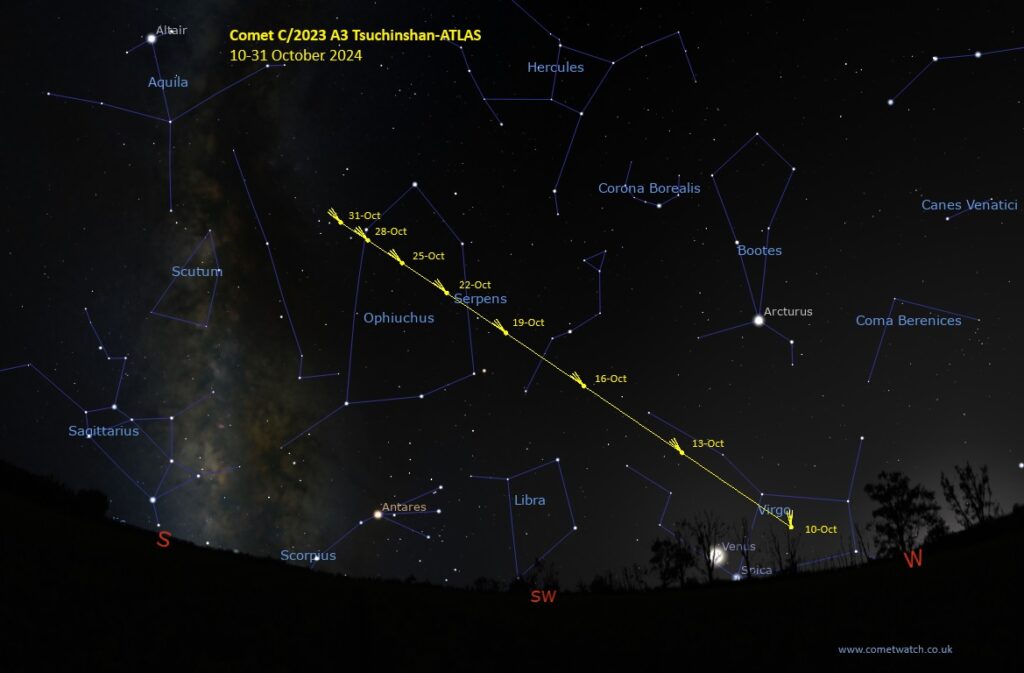
Comet C/2023 A3 (Tsuchinshan-ATLAS), a celestial object first discovered by two independent observatories, is currently captivating skywatchers as it transitions from the morning to the evening sky. The comet was originally spotted by the Tsuchinshan Observatory in China, and later by the ATLAS (Asteroid Terrestrial-impact Last Alert System) program, which specializes in scanning the night sky for near-Earth objects. Since its discovery, Comet Tsuchinshan-ATLAS has steadily increased in brightness, making it an exciting target for both amateur astronomers and seasoned observers alike.
Throughout September, the comet brightened as it approached the Sun, becoming visible in the early morning hours. Recent observations have confirmed that Comet Tsuchinshan-ATLAS is now transitioning from the dawn sky to the dusk, offering a new opportunity to witness this cosmic spectacle during evening hours. With its visibility improving and its path taking it higher in the night sky, the next few weeks are prime viewing time for those eager to catch a glimpse of this icy visitor.
How Bright is Comet Tsuchinshan-ATLAS Now?
At the time of writing, recent observations suggest that Comet Tsuchinshan-ATLAS has brightened significantly during perihelion, reaching an impressive brightness of around magnitude -2. This makes it easily visible to the naked eye, particularly from rural areas with minimal light pollution. Even in areas with moderate light pollution, the comet can be observed with the aid of binoculars or a small telescope.
The comet’s coma, a glowing cloud of gas and dust surrounding its nucleus, has become more pronounced, and its tail is also starting to extend further, making it a striking sight for observers. With its magnitude now at -2, Comet Tsuchinshan-ATLAS is now one of the brighter objects in the night sky however competing with the evening twilight.
Where is Tsuchinshan-ATLAS ?
As of early October 2024, Comet Tsuchinshan-ATLAS is transitioning from the morning sky to the evening sky, becoming visible shortly after sunset. It is currently positioned low in the western sky, making its ascent higher each evening, giving skywatchers an increasingly favorable opportunity to observe it under darkening skies.
The comet is located near the constellation Virgo, moving slowly as it continues its journey through the inner solar system. Observers from the Northern Hemisphere have the best view, with the comet appearing higher in the sky as the month progresses. It will pass closest to Earth in mid-October, making this period an ideal time for observation. From this point, Comet Tsuchinshan-ATLAS will continue to move westward, offering clearer views as it distances itself from the Sun and twilight fades
Comet C/2023 (A3) Finder Chart – October 2024

Comet Tsuchinshan-ATLAS is putting on an impressive display as it moves to the evening skies in early October 2024. Now shining at around magnitude -2, the comet is easily visible to the naked eye in dark locations, with its brightness and tails making it a spectacular sight. Many spectacular images have been circulating online from southern sky observers as the comet has rapidly brightened towards perihelion.
As it transitions higher into the evening sky, this period offers an ideal opportunity for comet enthusiasts and astronomers to capture its beauty. With its closest approach to Earth still ahead and predictions suggesting further brightening, Comet Tsuchinshan-ATLAS is poised to become one of the most memorable cometary events of the year.
Be sure to mark your calendars for its peak visibility in mid-October, and keep an eye on the sky for this cosmic visitor.
